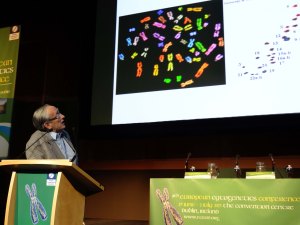
Among the exciting Plenary Sessions at the European Cytogeneticists Association conference in Dublin – #ECA2013 – one marked 100 years since publication of Alfred H Sturtevant’s landmark research paper presenting the first genetic map of a chromosome (1913: J. Exp. Zool., 14 (1), 43-9. URL http://dx.doi.org/10.1002/jez.1400140104 but see http://www.esp.org/foundations/genetics/classical/holdings/s/ahs-13.pdf for the original paper and a commentary by Robert J. Robbins). In his seminal publication “The linear arrangement of six sex-linked factors in Drosophila, as shown by their mode of association”, Sturtevant built on his earlier work with Thomas Hunt Morgan on recombination, and showed that trait genes were at fixed chromosomal loci, thus establishing the concept of genetic mapping. Sturtevant (1891-1970) also made other significant contributions including to what was later known as unequal, illegitimate or non-homologous crossing-over, recombination, mutation and the social impacts of genetic research. Both speakers in the session started their talks with pictures of Alfred Sturtevant and discussed the legacy of his work in Drosophila that underpins cytogenetics and genomics today.
Malcolm Ferguson-Smith’s (Cambridge, UK) presentation on “Comparative studies of chromosome conservation, size and GC content” discussed his wide-ranging research across all vertebrates using flow cytometry and chromosome sorting with in situ hybridization. Genome size measurements are much more accurate from these techniques than sequencing because gaps and wrongly assembled or missed duplications can underestimate or overestimate chromosome sizes.

Malcolm’s lab’s homepage, http://chromhome.vet.cam.ac.uk/ (CHROMosome HOmology Mapping & E-painting) has extensive information about comparative genomics and the chromosome painting probes available, and in the talk we were given an overview of some of the range of important results obtained: the 200 rearrangements between mouse and human chromosomes, now confirmed by sequencing; the fusion of chromosomes in the Stone Curlew bird, unusual in having only 2n=42 chromosomes compared to most birds with 70 to 80 chromosomes; and the range of homologies between bird and reptile sex chromosomes and autosomes. The range of rearrangements would be very hard to find by analysis of even multiple single-copy gene sequences, and the final part of the lecture speculated on the nature of the DNA sequences that give rise to the cross-species painting. The hypothesis presented suggested that chromosome-specific, non-coding sequences of undefined function have evolved to allow chromosome synapsis in meiosis and prevent illegitimate non-homologous recombination, and these sequences hybridize across species and hence give the insight into comparative chromosome evolution when used as chromosome paints.
The second talk by Evan E Eichler (Seattle, USA; lab homepage http://eichlerlab.gs.washington.edu/index.html) was on “Switching the order in a structurally complex human genome” and focussed on his research on the predisposition of parts of the human genome to structural variation. He started by showing how the complex pattern of segmental duplications, and their dispersed nature, sensitizes our genome to copy number variation in these areas, and the changes are associated with a range of neuropsychiatric disorders. New results showed that there was a burst of segmental duplications 8 to 12 Mya, corresponding to core-associated duplications on six human chromosomes; these regions show recurrent rearrangements in gene order, leading to large-scale structural polymorphisms between human populations. Evan then presented the core duplicon hypothesis based on evidence that the cores are independently amplifying, and the selective disadvantage of interspersed duplications is offset by the benefit of evolutionary plasticity and emergence of new genes with new functions associated with amplification.
The well-attended session showed how 100 years of research on chromosomes, and the comparative analysis of different species and populations over evolutionary timescales, is leading to fundamental discoveries about the nature of the genome and consequences for speciation and disease. Both speakers were using a wide range of techniques and integrating this into new models of chromosome structure and sequence modulation that could not be obtained using one method alone.
My own talk to the Animal and Plant Cytogenetics session is here, while I have also posted a review of the Animal, Plant and Comparative cytogenetics Permanent Working Group meeting.

One Comment Add yours